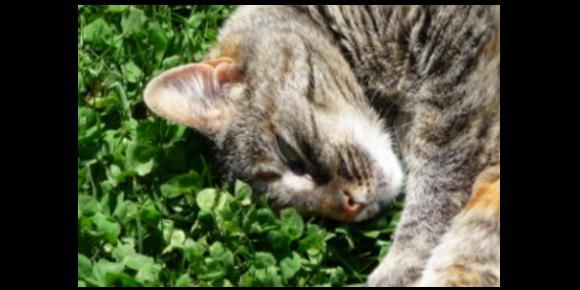Aortic Thromboembolism in Cats

- posted: Jan. 13, 2019
Aortic Thromboembolism in Cats
Last week, you may have seen our Facebook post about a lovely patient named Pippin who we lost due to a condition called Feline Aortic Thromboembolism. I thought I would use this opportunity to talk a little more about this serious medical condition that is unique to cats.
Feline Aortic Thromboembolism is also sometimes known as “FATE” or “saddle thrombus.” Essentially, what happens is a blood clot forms and travels within the vascular system where it often gets stuck in the body’s largest blood vessel, the aorta, in the area where the aorta splits into the femoral arteries which supply blood to the hind legs. This stops blood flow to one or both hind legs causing the classic presentation of FATE in which the cat is very painful, cannot use one or both of his hind legs, and the legs feel cold and stiff due to loss of circulation. While the hind limbs are most often affected, clots can also lodge in arteries that supply the front legs, kidneys, brain or other areas of the body causing significant damage due to loss of blood flow.
Clot formation is usually due to underlying heart disease like hypertrophic cardiomyopathy (thickened heart muscle) but clots have also been known to form in a small number of cats with various forms of cancer. It is thought that some cancers can affect platelet function causing clots to form. What makes this disease so frustrating is that about 70% of the cats with FATE have no clinical signs, no heart murmur, no indication that anything is wrong UNTIL the clot forms. Sadly, we usually have no idea that a cat is at risk until the thrombus or clot occurs.
Can the condition be treated? Treatment can be attempted, but the prognosis for recovery from this condition is very poor. If the clot can be broken up and function restored to the hind legs, some cats may recover. However, even if the clot is resolved, the underlying heart disease or cancer still remains and cats who have survived an episode of FATE are at high risk for recurrence. Only 20% of cats survive one year beyond treatment of a thrombus and all cats studied with this condition were euthanized or died due to complications from heart disease and/or recurrence of a blood clot.
Treatment involves controlling the pain associated with the lack of blood flow to the hind legs and with reperfusion of the affected limbs, treating any signs of congestive heart failure such as fluid in the lungs with drugs and oxygen therapy and, trying to break up the clot with medications such as heparin, Plavix or aspirin. We still need more studies and more data on how effective these clot-busting treatments really are and, if paralysis persists beyond 48 hours, prognosis for recovery is very poor.
Thankfully, we do not see this condition too frequently, but, the handful of cases we do see each year are always quite sad. There are no good screening tests to look for this problem, however, if your cat has been diagnosed with a heart murmur or hypertrophic cardiomyopathy he may be at risk.
This blog brought to you by the Patton Veterinary Hospital serving Red Lion, York and the surrounding communities.
Location
Patton Veterinary Hospital
425 E Broadway
Red Lion, PA 17356
